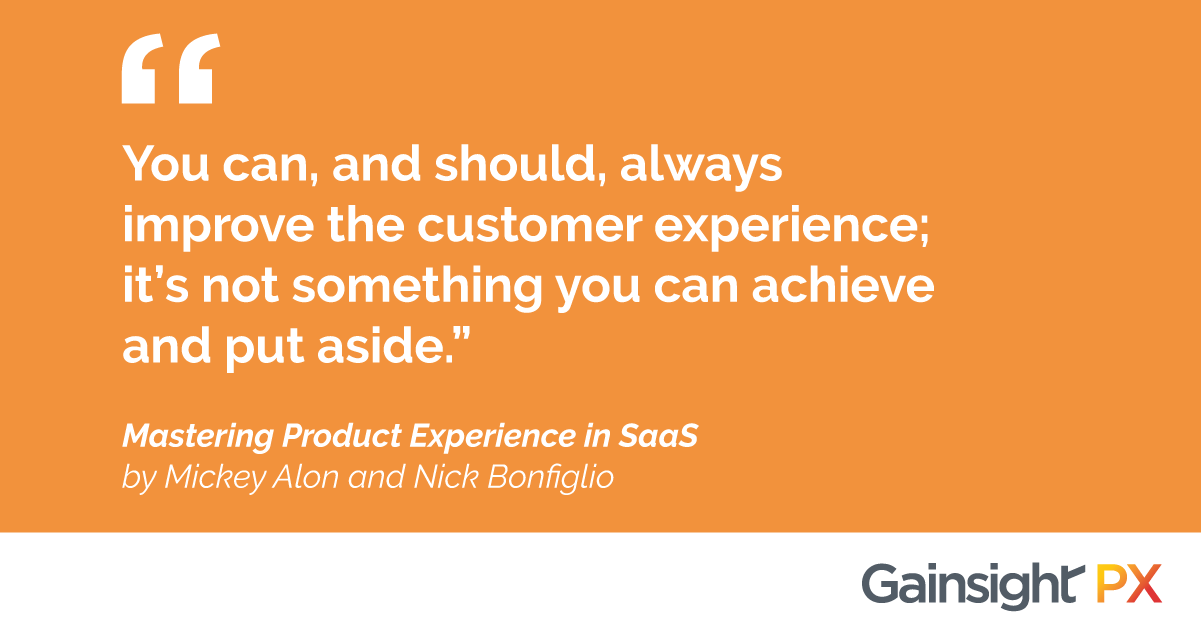Are the right people driving product experience in your company?
The Age of the Customer has increased the importance of delivering exceptional customer experiences and outcomes. With the onus falling upon the entire company to produce a great customer experience, more and more functional departments are claiming ownership. Marketing, customer success, support, product—each team plays a critical role. However, each department has a different motivation stemming from its own functional responsibilities and resources. While we do adhere to the belief that delivering exceptional experiences is a company-wide initiative, who takes lead when it comes to product experience?
It’s no argument that core product functionality, UX, and design are created and owned by product, engineering, and design teams. But if you want to master product experience, you must go beyond functionality and include all the other types of interactions that happen during a user’s experience with your product. I’m talking about touchpoints like training, onboarding, and adoption. This is where the challenge comes to light.
Driving Product Experience is a Team Effort
You may be thinking, “Product experience should be owned by product teams—after all, it’s in their name.” But it’s not as simple as that. As mentioned above, product experience isn’t just driven by in-product experiences, it also requires efforts from your customer-facing teams. Both customer success and product teams are bound by similar goals: incentivize customers to use their new features so they continue to return and get value. Product teams can’t do this without a customer-facing counterpart, but they also shouldn’t rely solely on customer success teams to drive adoption.
Depending upon your company’s product roadmap, you might be shipping and refining new product updates monthly, weekly, or even daily. No matter what your release cadence is, your products are in a constant state of change and your customer success team is expected to keep up. If CS isn’t equipped to handle all the training and education these new developments require, then their full value will never be realized.
Does this sound familiar? You release a new feature. Product attempts to increase awareness of this capability through feature notes. This has a broad reach but doesn’t target specific users that might find immediate value from this new development. Instead, it goes to people that don’t find it relevant and the announcement falls on deaf ears.
CS teams have a deeper level of insight, on a granular level. They work directly with customers every day and know which ones will directly benefit from your new development. However, it can be harder to get the word out because they need to wait for the next 1:1 conversation with each relevant customer.
Breaking down silos and emphasizing company-wide alignment can help fill each department’s gaps. This doesn’t just add internal efficiency, it also creates a smoother product experience for customers. But in order to succeed with this many involved parties, you need to clearly define ownership and accountability.
Product Experience Management and Accountability
Saying that product experience is a team effort is one thing, executing on that claim is another. Scalable, effective product experience execution requires alignment across roles with metrics that hold each stakeholder accountable.
The responsibilities and metrics in a holistic PX strategy might look like this:
- Product: Manages a product development strategy and vision and creates enticing GTM strategies to drive feature adoption. Success is measured in MAU, DAU, or CLV.
- Customer Success: Onboards, trains, upsells, and renews customers while developing workflows that constantly re-engage existing customers. Success is measured in renewal rate, NPS, CLV, or retention rate.
- Sales: Conducts demos and qualification calls that help and guide users to move down the funnel. Success is measured in CLV or conversion rates (MQL to SQL, SQL to closed won, etc.).
- Marketing: Generates content, campaigns, and ads that drive awareness of product value and supports newsworthy feature releases. Success is measured in CAC, CLV, and trial signups.
Gainsight PX is a product experience platform that helps users find value in the features you worked so hard to create. Increase adoption through easy-to-use, in-app engagements and fuel your roadmap with data-driven user insights. Sign up for a demo today.
Who Owns Product Experience at Gainsight
The short of it is that no one department owns product experience. At Gainsight, our product and customer success teams are aligned to the KPI of increasing product adoption, and both from a different perspective. Product looks at the total percentage of adoption across the entire customer base, whereas CS looks at adoption within customers accounts.
Product owns the initial introduction and activation of newly released capabilities in the form of a release experience. They use a variety of methods to drive awareness of new capabilities. This includes sending announcement emails, hosting webinars for upcoming and recent product releases, and establishing in-app messages and hotspots.
After this initial announcement is made, Product then sets up in-app guides. These are personalized by user segment based on product usage analytics. A sampling of real customer engagement with feature, analysis, and user feedback fuels future iterations of particular feature sets and guides where these new capabilities fit within the overall customer adoption journey.
CS owns overall product adoption. They’re in charge of creating tailored training plans and educational experiences to help their accounts become more proficient in our products. They’re very tuned into each individual account’s idea of success. Using this as their north star, they employ a number of in-person and in-product touches to guide customers from initial onboarding to activation of pertinent product capabilities.

Who Owns PX Within Your Company?
Gainsight’s method is just one way to break down PX responsibilities. It’s certainly not the only way and we expect that we will refine and tweak over time. We’d love to hear how you think about the responsibilities and actions associated with product adoption in your organization. Let us know in the comments below!

